Cabañeros: Galería multimedia
Cabañeros: Galería multimedia
 La raña es una gran llanura situada entre sierras salpicada de encinas (Quercus ilex), alcornoques (Quercus suber) y quejigos (Quercus faginea).
La raña es una gran llanura situada entre sierras salpicada de encinas (Quercus ilex), alcornoques (Quercus suber) y quejigos (Quercus faginea).
 La raña es la imagen más emblemática del parque. Este paisaje ha sido modelado durante siglos, por las actividades humanas.
La raña es la imagen más emblemática del parque. Este paisaje ha sido modelado durante siglos, por las actividades humanas.
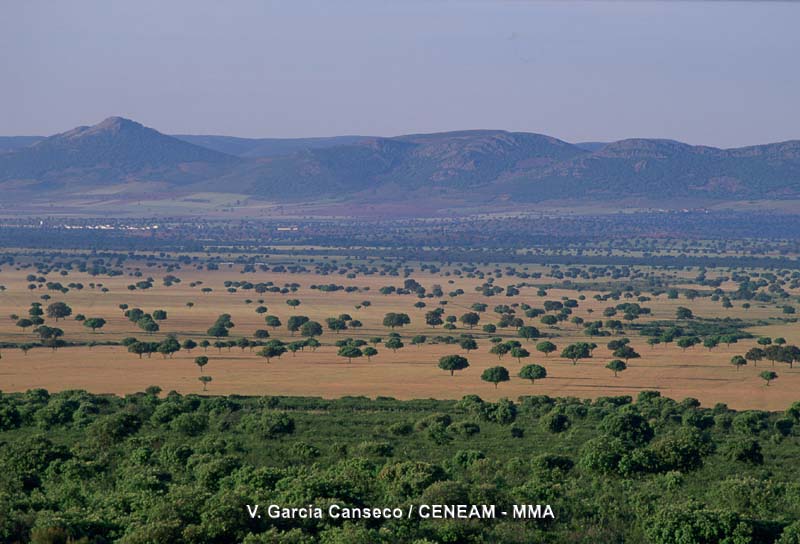 Vista general de la raña.
Vista general de la raña.
 En primavera la raña aparece cubierta de numerosas especies en flor, como aulagas (Genista hirsuta) y cantuesos (Lavandula stoechas).
En primavera la raña aparece cubierta de numerosas especies en flor, como aulagas (Genista hirsuta) y cantuesos (Lavandula stoechas).
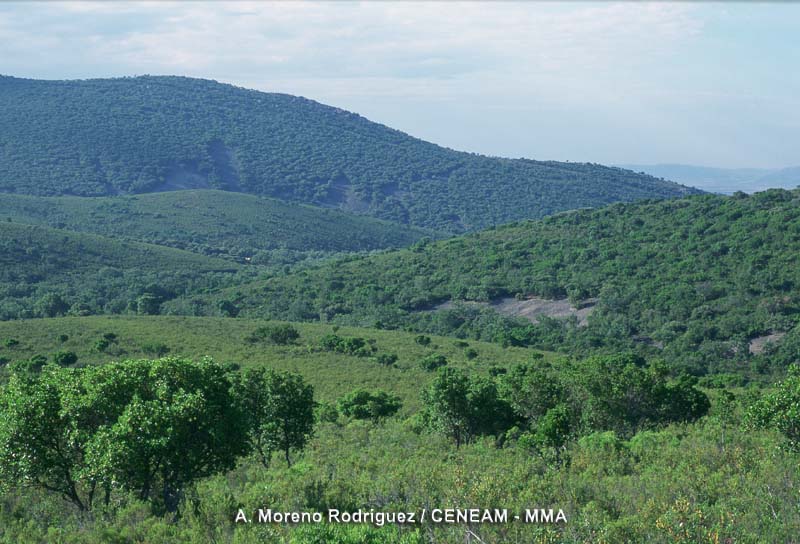 El monte mediterraneo protege al suelo de la erosión, y da sustento y cobijo a los animales que habitan en el parque.
El monte mediterraneo protege al suelo de la erosión, y da sustento y cobijo a los animales que habitan en el parque.
 La presa del brezoso facilita agua al parque, sobre todo durante el verano.
La presa del brezoso facilita agua al parque, sobre todo durante el verano.
 En los suelos más húmedos y profundos de cabañeros, encontramos bosques constituidos fundamentalmente por robles melojos o rebollos (Quercus pyrenaica).
En los suelos más húmedos y profundos de cabañeros, encontramos bosques constituidos fundamentalmente por robles melojos o rebollos (Quercus pyrenaica).
 El brezo de turbera (Erica tetralix) vive en zonas húmedas con aguas ácidas y pobres en nutrientes. Estos lugares son los denominados trampales.
El brezo de turbera (Erica tetralix) vive en zonas húmedas con aguas ácidas y pobres en nutrientes. Estos lugares son los denominados trampales.
 La jara pringosa (Cistus ladanifer) es una de las especies más abundantes de la zona.
La jara pringosa (Cistus ladanifer) es una de las especies más abundantes de la zona.
 La estepa blanca (Cistus albidus) de bellas flores rosadas, debe su nombre común al color blanquecino de sus hojas y ramas.
La estepa blanca (Cistus albidus) de bellas flores rosadas, debe su nombre común al color blanquecino de sus hojas y ramas.
 El madroño (Arbutus unedo) aparece en las zonas de encinares y alcornocales degradados. Para crecer, necesita un clima suave sin fuertes heladas.
El madroño (Arbutus unedo) aparece en las zonas de encinares y alcornocales degradados. Para crecer, necesita un clima suave sin fuertes heladas.
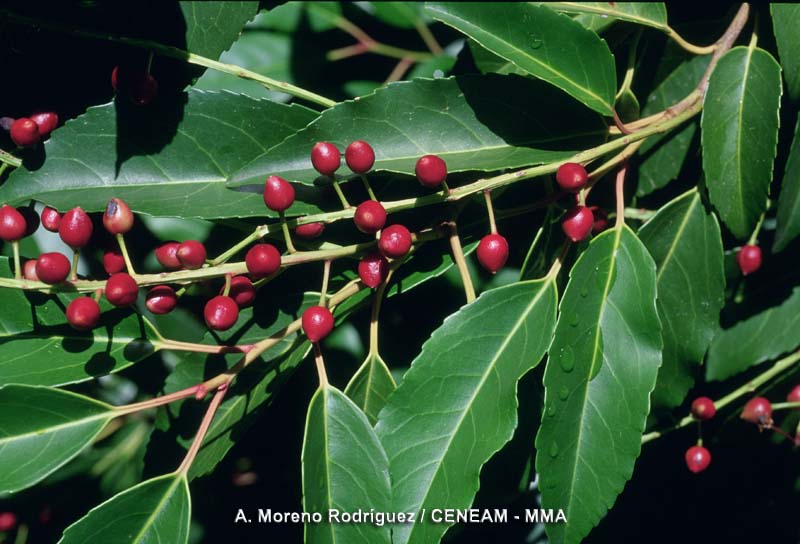 El loro (Prunus lusitanica), es un pequeño árbol que ha sido capaz de sobrevivir desde la era terciaria hasta nuestros días. Se le puede considerar un fosil viviente.
El loro (Prunus lusitanica), es un pequeño árbol que ha sido capaz de sobrevivir desde la era terciaria hasta nuestros días. Se le puede considerar un fosil viviente.
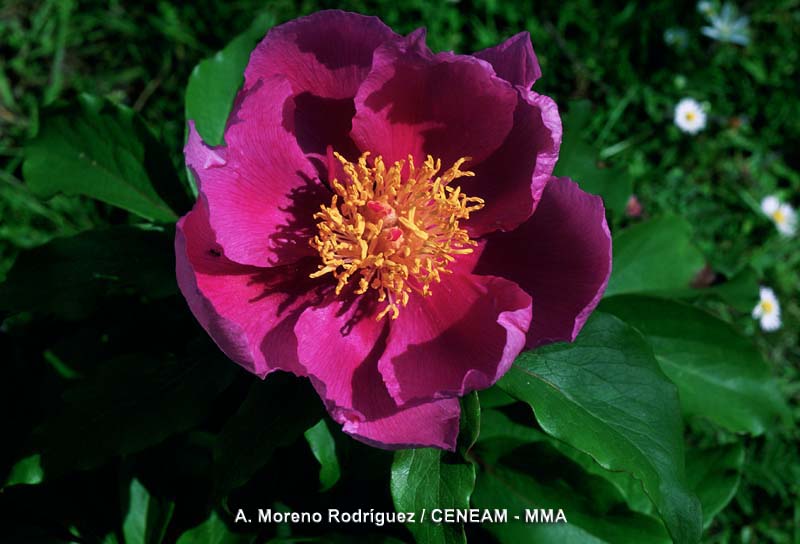 Todas las primaveras las peonias (Paeonia broteroi) florecen en las partes mas sombrías del bosque.
Todas las primaveras las peonias (Paeonia broteroi) florecen en las partes mas sombrías del bosque.
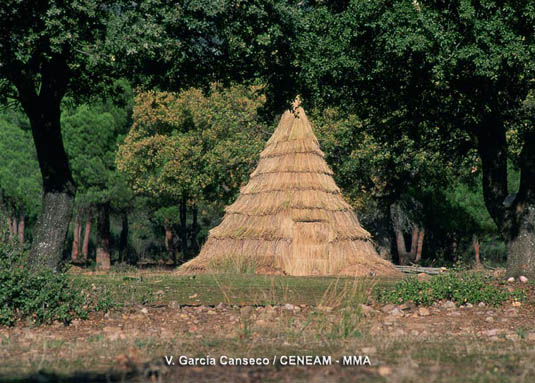 Las cabañas eran construcciones temporales, que han dado el nombre al parque. En ellas vivian los antiguos pobladores que se dedicaban fundamentalmente al carboneo y el pastoreo.
Las cabañas eran construcciones temporales, que han dado el nombre al parque. En ellas vivian los antiguos pobladores que se dedicaban fundamentalmente al carboneo y el pastoreo.
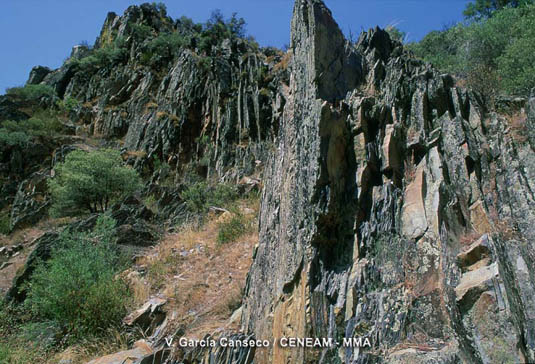 Muchas de las formaciones rocosas de Cabañeros con formas caprichosas y accidentadas, están constituidas por cuarcitas.
Muchas de las formaciones rocosas de Cabañeros con formas caprichosas y accidentadas, están constituidas por cuarcitas.
 El río Estena recorre el parque y es uno de los afluentes más importantes del rio Guadina en su tramo medio.
El río Estena recorre el parque y es uno de los afluentes más importantes del rio Guadina en su tramo medio.
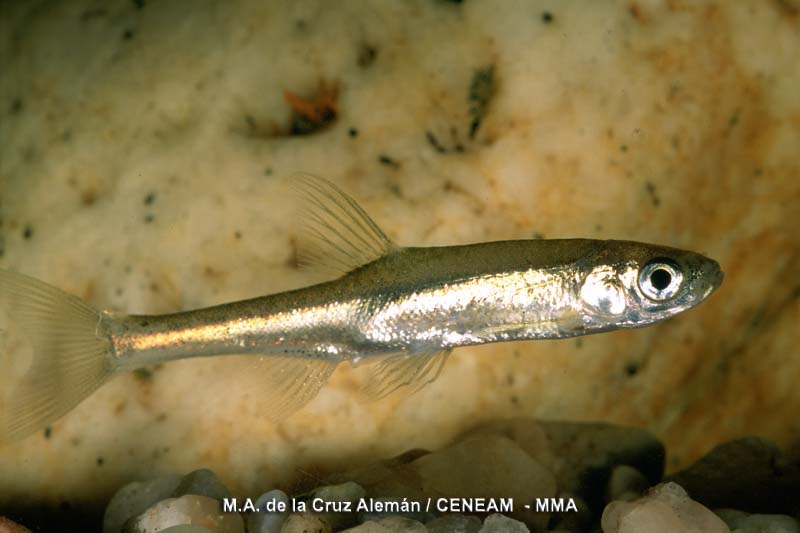 El jarabugo (Anaecypris hispanica), es un pez endémico de la cuenca del Guadiana. En el río Estena se encuentra la mejor población de España de esta especie.
El jarabugo (Anaecypris hispanica), es un pez endémico de la cuenca del Guadiana. En el río Estena se encuentra la mejor población de España de esta especie.
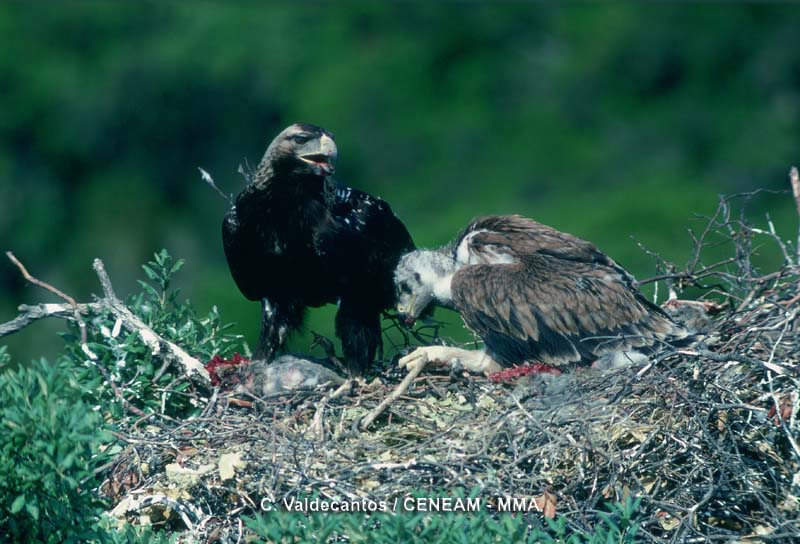 En cabañeros todavía se observa con cierta facilidad, a una de las especies más amenazadas de la fauna española, el águila imperial (Aquila adalberti).
En cabañeros todavía se observa con cierta facilidad, a una de las especies más amenazadas de la fauna española, el águila imperial (Aquila adalberti).
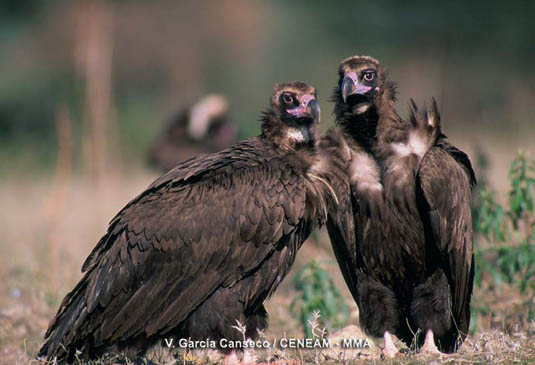 El buitre negro (Aegypius monachus) tiene en el parque el segundo núcleo de cría más importante de Europa.
El buitre negro (Aegypius monachus) tiene en el parque el segundo núcleo de cría más importante de Europa.
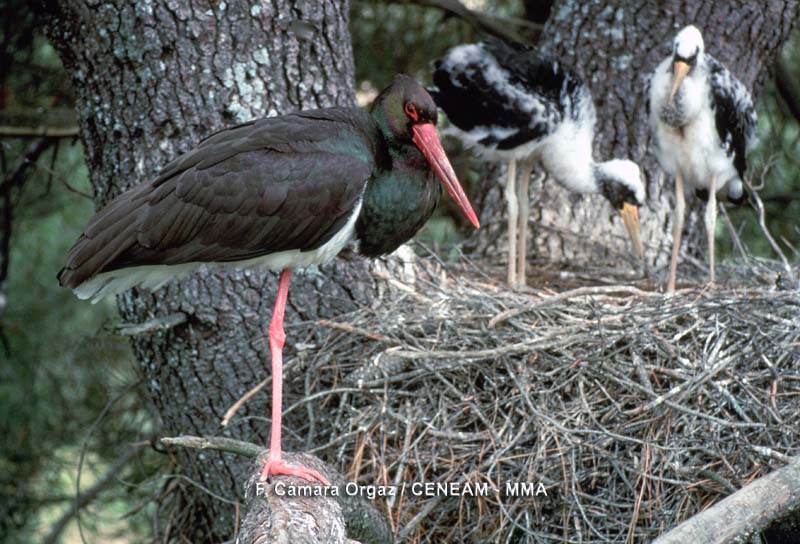 La esquiva cigueña negra (Ciconia nigra), anida en árboles de gran altura. Se alimenta de peces, anfibios y grandes insectos.
La esquiva cigueña negra (Ciconia nigra), anida en árboles de gran altura. Se alimenta de peces, anfibios y grandes insectos.
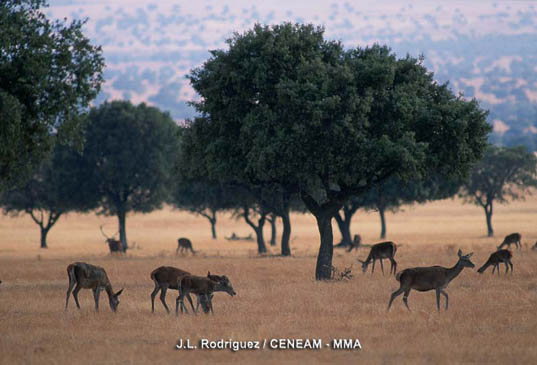 Los ciervos (Cervus elaphus) son los mamíferos más abundantes y fáciles de observar en Cabañeros, sobre todo en la época de la berrea.
Los ciervos (Cervus elaphus) son los mamíferos más abundantes y fáciles de observar en Cabañeros, sobre todo en la época de la berrea.
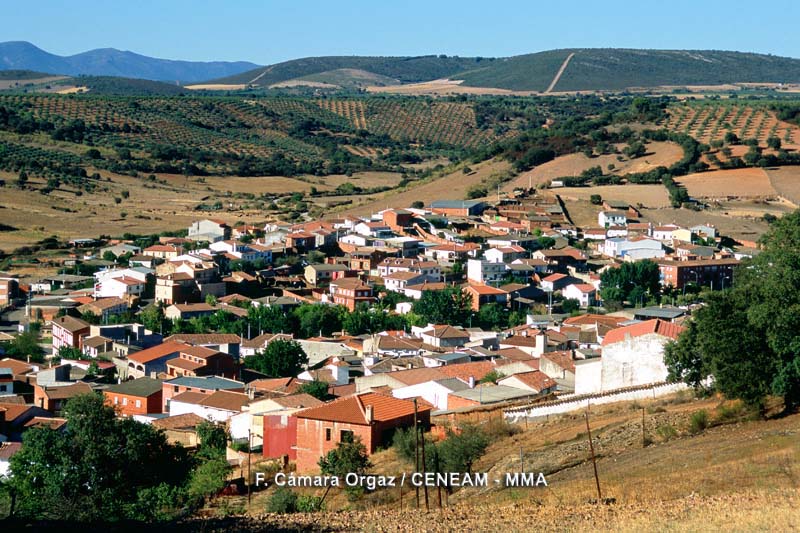 Las principales actividades económicas de los habitantes de los pueblos de la zona son la ganadería y al agricultura.
Las principales actividades económicas de los habitantes de los pueblos de la zona son la ganadería y al agricultura.
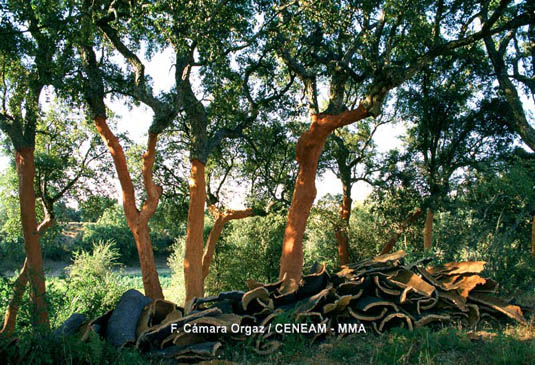 La extracción del corcho de los alcornoques se realiza cada ocho o diez años.
La extracción del corcho de los alcornoques se realiza cada ocho o diez años.
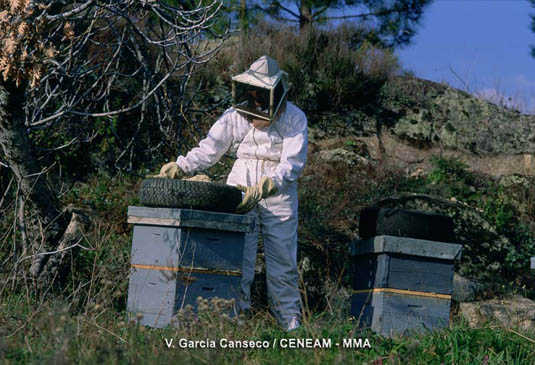 La apicultura,es una importante fuente de ingresos para los habitantes de los pueblos de la zona de influencia del Parque Nacional.
La apicultura,es una importante fuente de ingresos para los habitantes de los pueblos de la zona de influencia del Parque Nacional.
 El turismo ornitológico es una de las actividades más solictadas dentro del Parque Nacional.
El turismo ornitológico es una de las actividades más solictadas dentro del Parque Nacional.
This page provides information on cookies we use: We use our own and third-party cookies to keep your session active, personalise your experience, and collect anonymous statistics about how you use this website. You can choose to accept all cookies or select which types you'd like to allow. To learn more about the cookies we use, read our Cookies Policy.
We use two types of cookies on this site. First, there are Functional Cookies, which are essential for the website to work properly. They store session data to make your experience smoother and more convenient. On the other hand, Analytical Cookies collect information about how you use the portal, without personal data, helping us provide a better and more tailored service.
Introduction to the Use of Cookies on the MITECO.gob.es Website
Cookies are small files that are stored on your device when you visit a webpage. They are essential tools that help provide many of the services available on the information society. Among other things, cookies allow a webpage to store and retrieve information about a user's browsing habits or their device. Based on this information, they can be used to recognise the user and enhance the service provided.
Types of Cookies
Depending on the entity that manages the domain from which the cookies are sent and processes the data, there are two types of cookies: first-party cookies and third-party cookies.
There is also a second classification based on how long the cookies remain stored in the user's browser: session cookies and persistent cookies.
Finally, cookies can also be classified into five types based on the purpose for which the data is processed: technical cookies, personalisation cookies, analytics cookies, advertising cookies, and behavioural advertising cookies.
For more information on this, you can refer to the Guide on the use of cookies from the Spanish Data Protection Agency.
Cookies used on the website
The web portal of the Ministry for Ecological Transition and the Demographic Challenge uses Adobe Analytics, an analytics tool that helps website and application owners understand how visitors interact with their content. Adobe Analytics uses a small number of cookies to collect data and generate usage statistics for websites. This information is sent anonymously and is not shared with third parties under any circumstances. You can choose to accept or reject these cookies, as they do not affect the portal’s functionality. However, they help provide valuable information that allows us to offer a better and more tailored service. For more information about Adobe Analytics cookies and privacy, please refer to the following links:
Additionally, pages featuring content from social network X will only set cookies if the user is logged into the X site. For more details on these cookies, please refer to the following link: Privacy on Social Network X
Finally, a technical cookie named MITECO-compliance is stored, which is a first-party, technical, and session-based cookie. It manages user consent for the use of cookies on the website, remembering which users have accepted them and which have not, ensuring that those who have accepted are not shown cookie consent messages at the top of the page. This cookie is essential for the proper functioning of the portal.
Cookies Policy Acceptance / Rejection
The Ministry for Ecological Transition and the Demographic Challenge gives you the option to accept or reject cookies that are not essential for the portal's operation. Upon accessing the portal, a message will be displayed in the centre of the page with information about the cookie policy and the following options:
· Firefox
· Chrome
· Safari